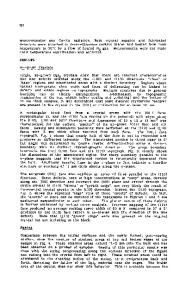Elemental Impurity Analysis of Mercuric Iodide by ICP/MS
- PDF / 234,824 Bytes
- 5 Pages / 414.72 x 648 pts Page_size
- 99 Downloads / 311 Views
ELEMENTAL IMPURITY ANALYSIS OF MERCURIC IODIDE BY ICP/MS
EILENE S. CROSS,* EUGENE MROZ** AND JOSE A. OLIVARES** *EG&G Energy Measurements, Inc., Santa Barbara Operations, Goleta, CA 93117 **Los Alamos National Laboratory, Isotope and Nuclear Chemistry Division, Los Alamos, NM. ABSTRACT A method has been developed to analyze mercuric iodide (HgI 2) for elemental contamination using Inductively Coupled Plasma/Mass Spectroscopy (ICP/MS). This paper will discuss the ICP/MS method, the effectiveness of purification schemes for removing impurities from Hgl 2, as well as preliminary correlations between HgI 2 detector performance and elemental contamination levels. INTRODUCTION Elemental impurities may be a contributing factor in the performance of HgI 2 detectors. Mercuric iodide is synthesized from an aqueous solution of potassium iodide and mercuric chloride. The raw HgI 2 goes through a series of purification steps which include vacuum sublimations, melts, resolidification, and closed system sublimations. Zone refining is also being used to purify starting chemicals and as a final purification step for the HgI 2. The purified HgI 2 is then grown into a single crystal by physical vapor transport. The crystals are cut into slices and they are fabricated into room temperature radiation detectors and photocells. Crystals that produce good resolution gamma detectors do not necessarily make good resolution photocells or x-ray detectors. Many factors other than elemental impurities may contribute to these differences in performance. A method has been developed to utilize ICP/MS to determine elemental impurities. ICP/MS analysis requires the dissolution of samples. Mercuric iodide is a difficult compound to analyze for trace quantities of elemental impurities for several reasons. The solvent must dissolve all impurities in the sample and it must be ultrapure. Sample size can be very limited, on the order of one gram or less. The major matrix components, mercury, iodine, and acid reagents, can obscure and interfere with the detection of the low levels of some elements present in the samples. There are two methods employed to dissolve HgI 2. The first is to dissolve the solid HgI 2 crystal in an aqueous solution of 1% KI. This technique dissolves the HgI 2 matrix but is probably not rigorous enough to dissolve particulate contaminants within the crystal structure. The second method is to use aqua regia as the solvent. This paper discusses this analytical method as applied to purification methods for HgI2 and KI. EXPERIMENTAL Sample Dissolution Method Dissolution of HgI 2 in high-purity (Seastar) nitric acid was not successful even with microwave digestion. Aqua regia (three parts HC1 and one part HNO3) is known to readily dissolve HgI 2. However, for ICP/MS analysis, it is desirable to avoid high concentrations of chloride because the formation of metal chlorides and oxychlorides interferes with the analysis (e.g., 35C1' 60 interferes with 5`V). Therefore, the minimum Mat. Res. Soc. Symp. Proc. Vol. 302. ©1993 Materials Resear
Data Loading...











